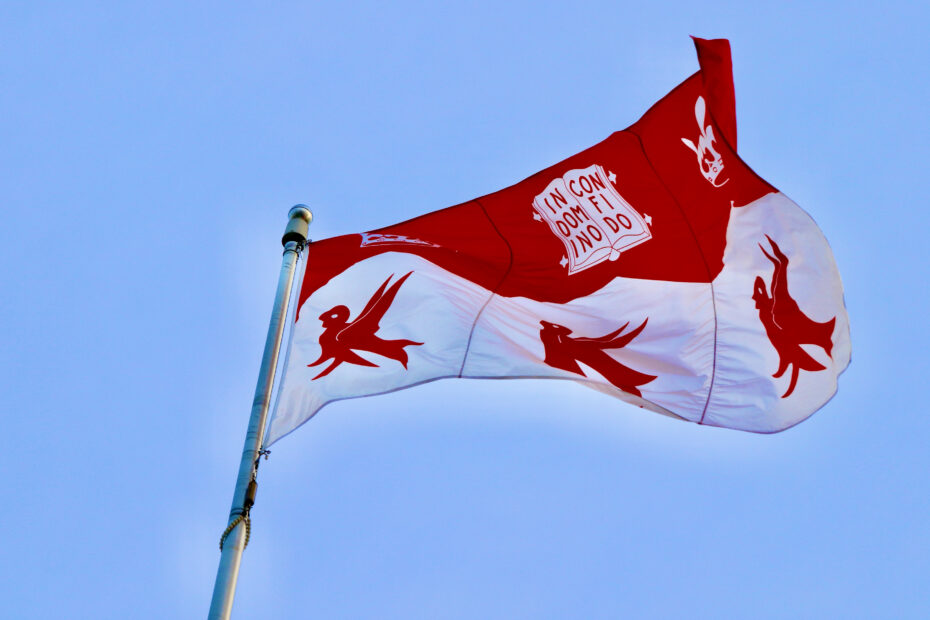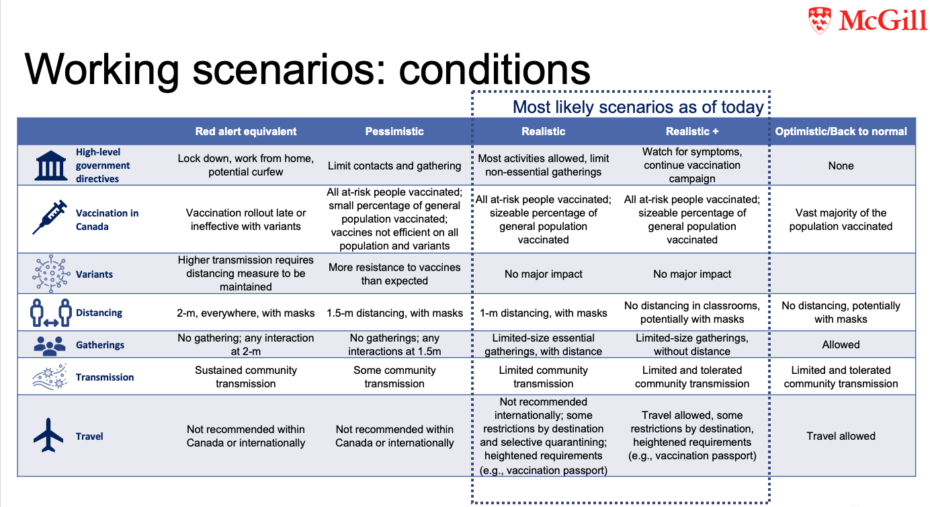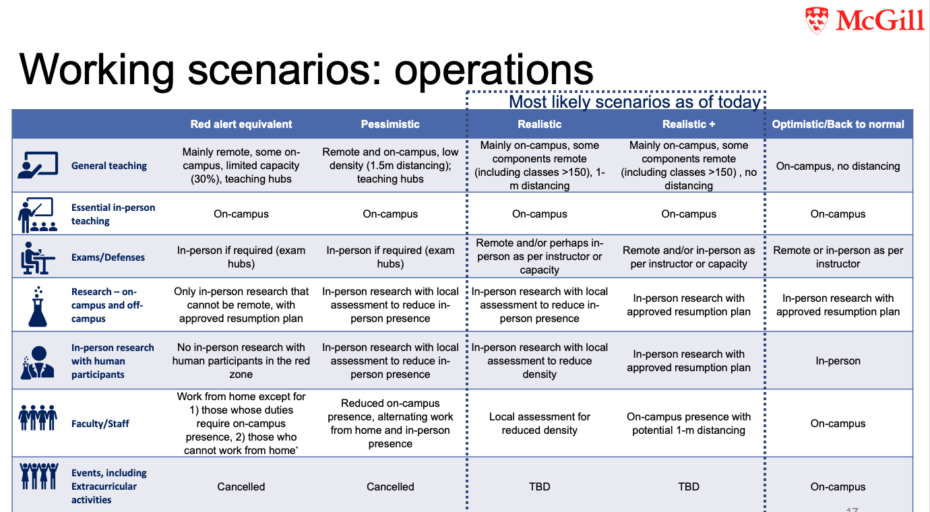
Last month, McGill announced a return to in-person teaching for the Fall 2021 semester, along with a progressive return to on-campus work for administrative and support staff. This past Friday, March 12, Christopher Buddle, Associate Provost (Teaching & Academic Programs), and Fabrice Labeau, Deputy Provost, Student Life and Learning, hosted a virtual Town Hall to discuss the extensive planning currently underway to prepare for this return. Close to 2,000 students, staff and faculty participated in the event.
A recording, which includes the question-and-answer period, is available online.
The Town Hall was held almost a year to the day that the World Health Organization declared COVID-19 a global pandemic – so beginning the McGill community’s pivot to a temporary new model of learning and working.
Principal Suzanne Fortier opened the Town Hall with an acknowledgement of the previous day’s national day of remembrance for the victims of COVID-19, offering “our condolences to all of you who have lost members of your family or close friends due to the pandemic.”
She went on to sound a note of cautious optimism for the year ahead.
“It is still not calm seas that we have in front of us,” she said, “but I think it may be fair to say that we’re starting to see the light at the end of the tunnel. We’re starting to see signs that we may be able to return to, maybe not what it was like totally pre-pandemic, but something that will be on the way to more normal conditions of working and studying together. We’re planning for a Fall 2021 where there will be a lot of activities on campus.”
Christopher Manfredi, Provost and Vice-Principal (Academic), echoed the Principal’s enthusiasm for a safe return to campus. “I very much look forward to welcoming everyone back to our campuses in September,” he said. “It’s really imperative that we return to campus, but this decision was not taken lightly, nor will it be implemented with haste, or without extensive plans established.”
A continuum of possible situations
Deputy Provost Labeau began his presentation by stating that the Fall 2021 planning follows the same principles that have guided all the University’s activities since the beginning of the pandemic: the health and safety of the community above all, the continuation of McGill’s core academic mission (including the student learning experience and research), and maintaining sound human resource and financial practices.
He went on to explain that the University’s planning “has to take into account the whole range” of five potential scenarios for September 2021, spanning every shade of the Quebec government’s colour-coded alert spectrum, as well as the possibility of “the ideal scenario, the-back-to-normal, where there is no pandemic anymore.”
Drivers
Labeau outlined the seven drivers that will help the University determine its place on the scenario continuum come September:
- Vaccine efficiency: As we continue having more data, we will have a better sense of the efficiency of vaccines in terms of preventing transmission and fighting variants.
- Vaccination rollout: The speed at which the general population is vaccinated in Quebec, Canada, and different parts of the world puts us in different situations in terms of the measures to be applied.
- Case trends: The level of community transmission, number of cases in hospitals, and corresponding status of the public healthcare system.
- Potential testing: Larger testing campaigns may allow for higher densities in activities.
- Government directives: The Ministry of Higher Education, for example, may issue specific instructions for universities.
- Travel restrictions: Measures such as quarantines or visa delays can have a direct impact on the ability of members of our community (especially international students) to be in Montreal and/or carry out activities such as fieldwork or exchanges.
- Expert advice: Throughout the pandemic, the University has consulted with our in-house scientific advisors to ensure up-to-date information about the evolving knowledge about the pandemic.
Current outlook
Labeau presented a matrix showing how each of the five scenarios would likely affect seven critical areas of operation: general teaching, essential in-person teaching, exams and defenses, research (on- and off-campus), research with human participants, faculty and staff, and events (including extracurricular activities).
 Given that Canada has begun rolling out three approved vaccines (and recently approved a fourth), yet considering the unlikelihood that everyone will be vaccinated by the time the Fall semester starts on Sept. 1, Labeau thinks it’s reasonable to largely rule out the most pessimistic and optimistic scenarios. (“But we’ll keep an eye on them to make sure we’re ready for them,” he notes.) Rather, he says the University is anticipating one of two scenarios “somewhere on what I would call the cautiously optimistic side” of the continuum.
Given that Canada has begun rolling out three approved vaccines (and recently approved a fourth), yet considering the unlikelihood that everyone will be vaccinated by the time the Fall semester starts on Sept. 1, Labeau thinks it’s reasonable to largely rule out the most pessimistic and optimistic scenarios. (“But we’ll keep an eye on them to make sure we’re ready for them,” he notes.) Rather, he says the University is anticipating one of two scenarios “somewhere on what I would call the cautiously optimistic side” of the continuum.
The first such scenario, which Labeau labels “realistic,” would entail the completed vaccination of all at-risk people, along with “a sizable percentage” of the general population, and vaccines would have proven effective against virus variants. In this potential scenario, the government would allow most on-campus activities, but with limits on non-essential gatherings. The current two-metre physical distancing would be reduced to one metre.
The second scenario, dubbed “realistic plus,” is slightly more optimistic, with no physical distancing required in classrooms, allowing for larger in-person class sizes.
 Both scenarios would see teaching that is mainly done on campus, with some remote components in instances such as classes of more than 150 people. Extra-curricular activities will be evaluated when the University has clearer details about how academic activities will be implemented in September.
Both scenarios would see teaching that is mainly done on campus, with some remote components in instances such as classes of more than 150 people. Extra-curricular activities will be evaluated when the University has clearer details about how academic activities will be implemented in September.
“I know that there’s a lot of excitement about coming back to campus,” said Labeau, “but because we’ve been away for such a long time, for many of us there’s also a lot of apprehension. The whole idea of this presentation is to show you why we’re confident that the planning for the mostly in-person scenario is the wisest planning strategy now, and also the most likely scenario for the Fall. But also to make sure that you understand that we’re keeping an eye on the whole spectrum of possibilities here.”
With September still six months away, he said, every scenario will be continually re-evaluated based on the latest information, and taking into account any windows of opportunity or deadlines that may have passed.
Through informed planning, he said, the University “will make sure that we have a safe environment for everybody in September.”
Huge efforts
Both Principal Fortier and Provost Manfredi thanked everyone involved in the ongoing planning for Fall 2021.
“Returning to on-campus activity is actually a lot more work than shutting things down,” noted Manfredi. “Turning the machine back on is a lot more work than shutting it off.”
“We are still working with the condition that we’re not 100 per cent able to predict [what September will hold]” said Fortier, “so it requires a lot of work thinking of various scenarios so that we can have dynamic learning environment as well as safe environment for all of us… There’s no doubt about it, we will be evolving to a different situation than the one we’re in. And so it is essential for us to plan for it.”
Watch the Town Hall below:
